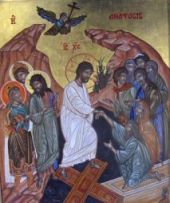These are some thoughts that I’ve had going through my head for some years, and I was finally motivated to write them down a couple of months ago in the context of certain discussions I heard concerning the Great and Holy Council. I shared them on Facebook then, but am posting them here now in order to have them more readily accessible.
When I was a Cistercian novice many years ago, I learnt an important lesson about order in the Church that I have been reminded of recently and that I suspect may have broader relevance.
As some may recall, the Rule of Saint Benedict states that the rank of the monks in the monastery is dependent on their date of entrance, irrespective of their age or social standing. Therefore, “someone who came to the monastery at the second hour of the day must recognize that he is junior to someone who came at the first hour.” Likewise, when a priest enters the monastery, his rank is based on “the date of his entry into the community, and not that granted him out of respect for his priesthood.” This rank orders the daily life, so that “when the monks come for the kiss of peace and for Communion, when they lead psalms or stand in choir” they do so in order of their entry into the monastery. While the abbot may make changes to this rank based on the virtue of their lives, he cannot allow this to be based on worldly considerations.
All this talk of rank may sound alien to our supposedly egalitarian world, but there is something crucially important going on here. Saint Benedict acknowledges and insists that a healthy community needs order. But, by basing that order on something relatively arbitrary, such as the hour of entry into the community, he is also explicitly ruling out an ordering of the community based on age, social distinction, wealth, or other worldly means of exercising power.
I didn’t pay too much attention to any of this initially when I was a novice. Like anyone else who enters a community, I was last in rank for a while, with those ahead of me being both younger and less educated than I was, but I never really bothered about it. But then somebody entered after me who had previously been in another community and who had great difficulty in having to be last in rank. That, and the way she had to work through it, made me realize that there was actually something very significant going on. I realized that it is precisely the arbitrariness of the rank that is a great gift, for it asks us to lay aside all our other identities and power games and accept the truth of who we are in real humility. What matters is not our rank, but our willingness to obey and accept the place given to us – and it is precisely this willingness to obey that indicates spiritual maturity.
I have been reminded of this as I witness some of the rather distressing power play going on in the Orthodox world at present. Like the Rule of Saint Benedict, the Church also has an order that she has inherited from her formative years, in which the ancient patriarchates have a certain rank and are expected to follow a certain order. And yet we now hear voices arguing that certain patriarchates should no longer be accorded primacy because they no longer have worldly might, while others that boast great wealth and power should be accorded a greater rank.
There is no doubt a certain logic to this, but I suspect that it is the logic of my fellow-novice (who was perhaps only articulating what all of us feel in some way) and not the logic of the Gospel, or of the Rule, or of the Church’s order. For this logic is based, not on our achievements or worldly power, but on our willingness to lay aside our own agendas and accept the place that is given to us in real humility. And it is precisely the arbitrariness of that place that is the greatest gift. For it allows all to submit to an order that is already given, rather than one that expresses our own will to power that constantly seeks to reassert itself.



